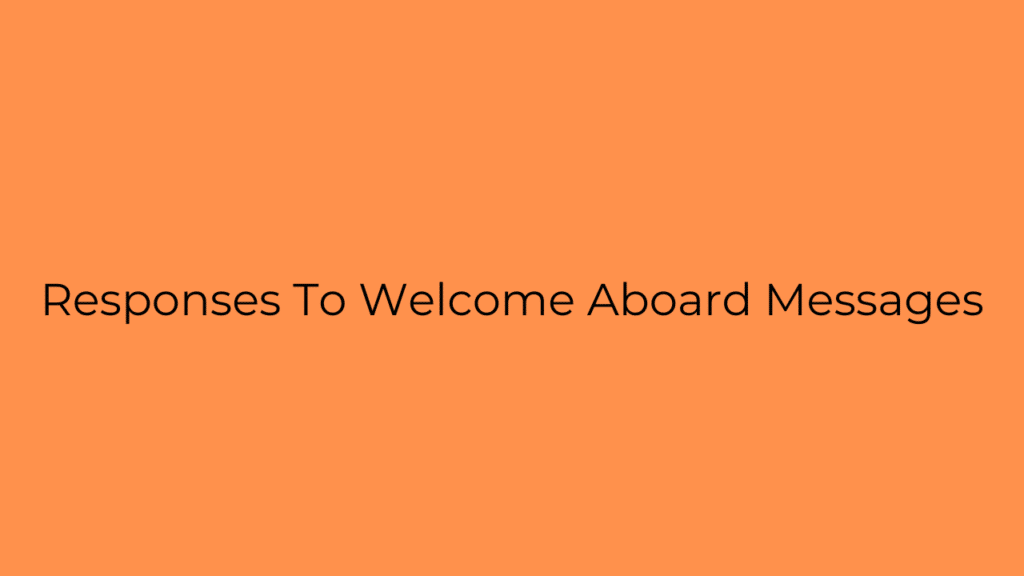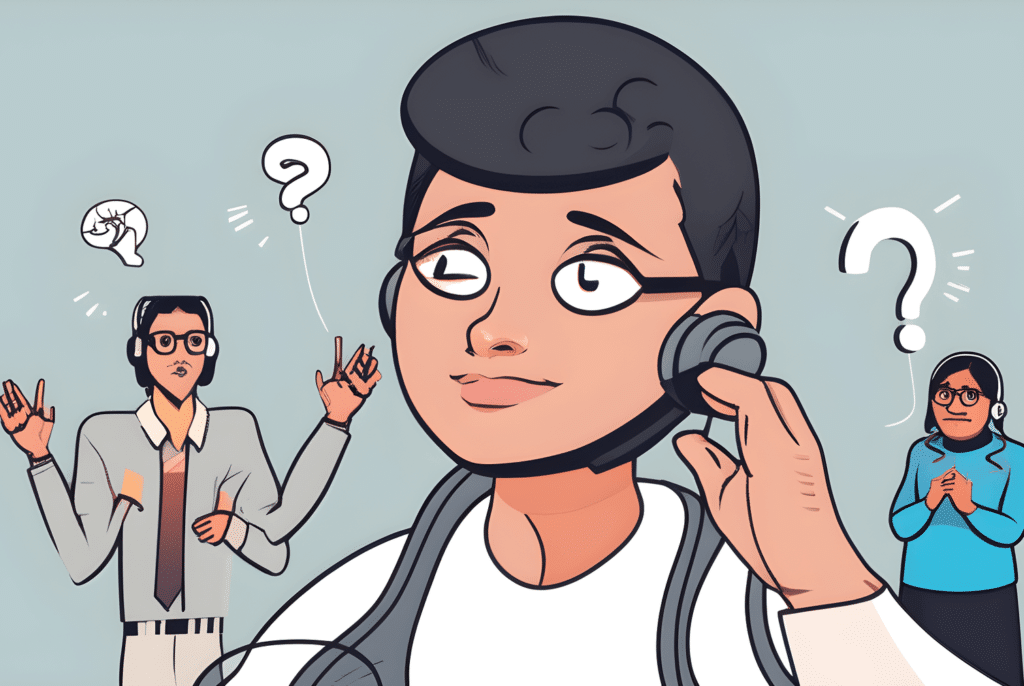Starting a new job or joining a new team can be both exciting and nerve-wracking. One of the most heartwarming moments during this transition is when you receive a “Welcome Aboard” message from your new colleagues or manager. These messages are meant to make you feel comfortable, valued, and part of the team right from the beginning. But what should you say in response? How can you craft a response that’s both professional and friendly?
In this article, we’ll explore the best ways to respond to “Welcome Aboard” messages, offering examples and tips for every situation. Whether you’re new to the workplace or simply looking for the best way to respond, we’ve got you covered!
Why Responding to Welcome Aboard Messages is Important
Before we dive into specific responses, it’s worth understanding why responding to “Welcome Aboard” messages is important. Your reply can:
- Make a Positive First Impression: A polite and thoughtful response shows you’re excited and ready to be part of the team.
- Demonstrate Professionalism: How you communicate reflects your work style. A warm yet professional reply is a good way to demonstrate your character.
- Build Connections: A sincere response can help establish rapport with your new colleagues.
- Boost Your Confidence: A well-crafted response can help you feel more confident in your new role.
Now, let’s go through some great ways to respond.
1. Basic Responses to “Welcome Aboard” Messages
When you receive a simple “Welcome Aboard” message, your reply should be gracious and upbeat. Keep it brief, but sincere.
Examples:
- “Thank you for the warm welcome! I’m excited to be here and look forward to working with everyone.”
- “Thank you! I’m excited to be part of the team and can’t wait to get started.”
- “I appreciate the warm welcome! I’m looking forward to contributing and learning from all of you.”
These responses are short but friendly. They acknowledge the welcome and express excitement for the future.
2. Responses with Gratitude and Enthusiasm
If you want to sound even more enthusiastic, consider adding more details or expressing your gratitude. Showing excitement for the opportunity will help you come across as positive and proactive.
Examples:
- “Thank you so much for the warm welcome! I’m thrilled to join this amazing team and I look forward to contributing my skills to help us reach our goals.”
- “I appreciate the warm welcome from everyone. I’m really excited to start this journey and look forward to collaborating with such a talented group of people.”
- “Thanks for the kind words! I’ve heard great things about the team, and I’m really excited to get started and contribute to our collective success.”
These responses are more detailed and show a genuine interest in your new team’s success. You could also add a bit of information about what excites you most about the job, whether it’s the team, the projects, or the company’s culture.
3. Acknowledging the Team’s Helpfulness
If your colleagues have already gone out of their way to help you or make you feel welcome, be sure to mention this in your response.
Examples:
- “Thank you for the warm welcome! Everyone has been so helpful already, and I can’t wait to dive in and work alongside such supportive colleagues.”
- “I appreciate the welcoming messages. It’s been a great first day, and I’m excited to learn from everyone on the team.”
- “Thanks for making me feel so welcome! I’m already excited about the positive energy and collaborative spirit here.”
These responses show that you’re not only grateful but also paying attention to the positive work culture around you.
4. Humorous or Casual Responses
In more relaxed or informal work environments, a humorous or casual response might fit better. Just make sure your tone matches the company’s culture.
Examples:
- “Thanks for the warm welcome! I promise I’ll try not to break anything on my first week!”
- “I’m excited to be on board. I’ve already made my coffee machine connection—feeling at home already!”
- “Thanks for the welcome! Looking forward to bringing my A-game and getting to know everyone!”
These responses are lighthearted but still show your enthusiasm and eagerness to contribute to the team. Just be careful not to overdo the humor—keep it professional, but fun.
5. Responding to “Welcome Aboard” from a Manager or Supervisor
When a manager or supervisor sends you a “Welcome Aboard” message, it’s important to acknowledge their leadership and express your readiness to contribute to the team. This response is slightly more formal but still warm and engaging.
Examples:
- “Thank you for the warm welcome! I’m excited to be part of the team and look forward to working together to achieve our goals.”
- “Thank you for the kind words! I’m eager to contribute to the team’s success and learn from your leadership.”
- “I appreciate your warm welcome! I’m excited to bring my skills to the team and collaborate with everyone on exciting projects.”
These responses show respect for your manager’s leadership and convey your excitement to contribute.
6. Replying to “Welcome Aboard” with a Follow-up Question
A great way to continue building rapport after a “Welcome Aboard” message is to follow up with a question. This can help you learn more about the team or organization while showing interest.
Examples:
- “Thank you for the welcome! Is there anything I should focus on during my first week to get up to speed?”
- “Thanks for the warm welcome! Do you have any recommendations on resources or tools I should check out as I start?”
- “I appreciate the kind words! Is there any project or task I can jump into right away to make myself useful?”
These responses show initiative and a willingness to engage with the work immediately. Asking questions demonstrates that you’re eager to contribute.
7. Team-Specific Responses
Sometimes, the welcome message will be from the team as a whole, rather than a single person. When this happens, it’s a great opportunity to show your excitement for working with the entire team.
Examples:
- “Thank you to the whole team for the warm welcome! I’m excited to be working with such a talented group of people.”
- “I’m so grateful for the warm welcome, team! I can’t wait to collaborate and contribute to our success.”
- “Thanks to everyone for the warm messages! I’m looking forward to getting to know you all better and working together on exciting projects.”
A team-specific response makes you seem approachable and enthusiastic about group collaboration.
8. Formal Responses for Corporate Environments
If you’re working in a formal corporate environment, your response may need to be more polished and professional. Use a tone that reflects the company’s culture while still being warm.
Examples:
- “Thank you for the warm welcome. I am honored to join such a distinguished team, and I look forward to contributing my skills to our shared success.”
- “Thank you for your kind words. I’m excited to start this new chapter and work with such a talented group of professionals.”
- “I appreciate the warm welcome. It’s a privilege to be a part of this organization, and I look forward to learning from all of you.”
These responses are respectful and show gratitude while maintaining professionalism.
9. Responses to Group Messages or Email Chains
When multiple people send you a “Welcome Aboard” message, it’s nice to acknowledge the group as a whole. If the messages are coming through email or a group chat, your response should be clear and appreciative.
Examples:
- “Thank you all for the warm welcome! I’m excited to be part of the team and look forward to working with each of you.”
- “I appreciate all the kind messages! I’m looking forward to getting started and contributing to the success of our team.”
- “Thank you, everyone, for making me feel so welcome! I’m eager to learn from all of you and collaborate on exciting projects.”
10. What Not To Do in Your Response
While it’s important to be friendly and professional, there are a few things to avoid in your response to a “Welcome Aboard” message.
- Don’t Be Too Casual: Avoid overly casual language, emojis, or slang unless the company culture supports it.
- Don’t Overdo It: Keep your message concise and to the point. Don’t write a lengthy response.
- Don’t Be Negative: Even if you’re nervous or unsure, avoid mentioning any doubts or negative feelings in your reply.
- Don’t Ignore the Message: Not responding at all can be seen as impolite or ungrateful.
11. A Table of Response Examples
Here’s a table summarizing different types of responses to “Welcome Aboard” messages, based on the situation:
| Situation | Example Response |
|---|---|
| Simple Welcome | “Thank you for the warm welcome! I’m excited to be here!” |
| Grateful & Enthusiastic | “Thank you for the warm welcome! I’m thrilled to join and look forward to working with you all.” |
| Acknowledging Helpfulness | “Thanks for the warm welcome! Everyone has been so helpful, and I’m excited to get started.” |
| Humorous Response | “Thanks for the welcome! I promise not to break anything on my first day!” |
| Manager or Supervisor Response | “Thank you! I’m eager to contribute and learn from your leadership.” |
| Follow-Up Question | “Thanks for the warm welcome! Any recommendations to help me get started?” |
| Team-Specific | “Thanks, team! I’m excited to work with such a talented group.” |
| Formal Corporate Environment | “Thank you for the warm welcome. I look forward to contributing to our shared goals.” |
Conclusion
Responding to “Welcome Aboard” messages is a small but important part of joining a new team. Your response sets the tone for your relationships with colleagues and shows that you’re both excited and ready to contribute. Whether you choose a casual, formal, or enthusiastic response, the key is to be sincere and genuine.
Remember, the best response is one that aligns with both your personality and the company culture. So, take a moment to craft a thoughtful reply that makes you feel confident and ready to take on the new challenges ahead!



